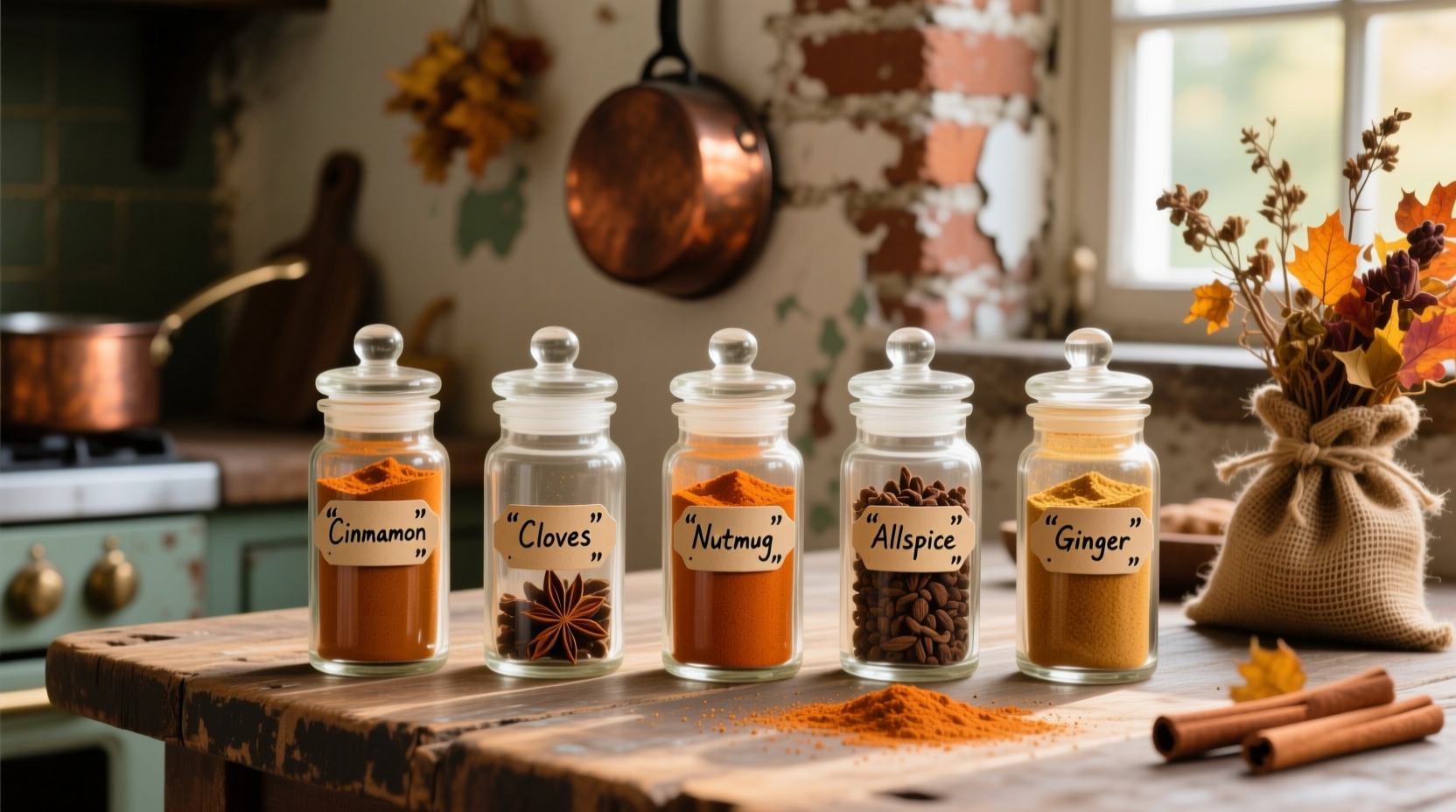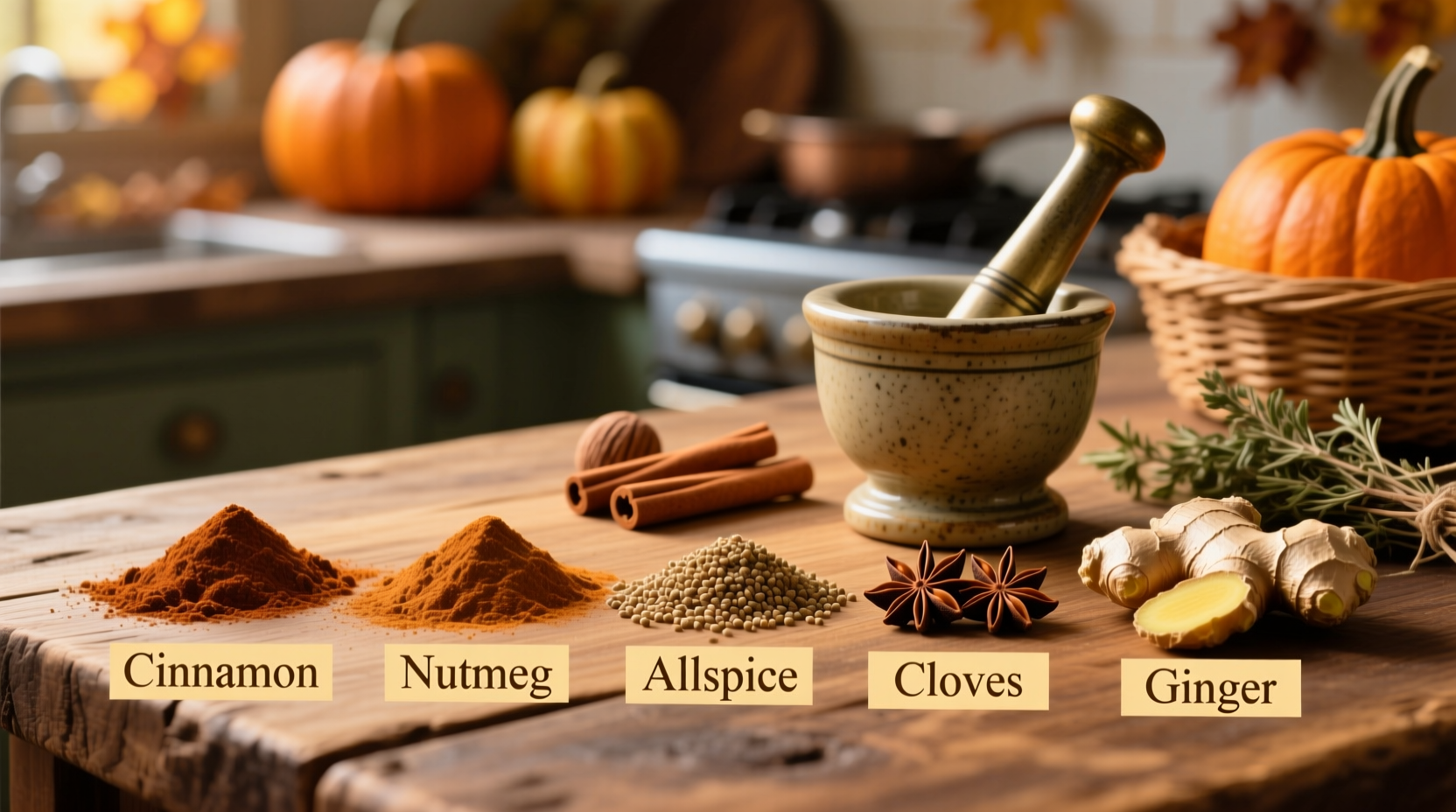Ever wonder why your favorite fall treats taste so distinctly seasonal? You're not alone. Millions search for the secret behind that comforting aroma wafting from coffee shops and bakeries each autumn. Understanding exactly what goes into pumpkin spice—and why these particular spices work together—can transform your seasonal cooking from ordinary to extraordinary.
What Exactly Is Pumpkin Spice?
Despite its name, pumpkin spice contains no pumpkin whatsoever. It's a carefully balanced blend of warming spices traditionally used in pumpkin pie recipes, hence the name. This aromatic combination has become synonymous with autumn flavors across North America, appearing in everything from lattes to candles.
The Core Spices: What Makes Pumpkin Spice Unique
While recipes vary slightly, authentic pumpkin spice always includes these five essential components:
| Spice | Typical Proportion | Flavor Contribution |
|---|---|---|
| Cinnamon | 60-70% | Warm, sweet base note with subtle woodiness |
| Ginger | 15-20% | Bright, slightly spicy warmth and zing |
| Nutmeg | 8-12% | Earthy, nutty depth with subtle sweetness |
| Allspice | 5-8% | Complex blend of clove, nutmeg, and cinnamon notes |
| Cloves | 2-5% | Intense warmth with distinctive pungency |
According to spice historians at the American Spice Trade Association, this particular combination emerged in 19th century American cookbooks as "pumpkin pie spice" before being shortened to today's "pumpkin spice." The proportions have remained remarkably consistent despite modern commercial variations.
Why These Specific Spices Work Together
These spices complement each other through a phenomenon food scientists call "flavor layering." Cinnamon provides the dominant sweet warmth, while ginger adds brightness that prevents the blend from becoming cloying. Nutmeg contributes earthy depth, allspice bridges the other flavors with its complex profile, and cloves deliver that signature spicy "kick" that makes pumpkin spice instantly recognizable.
Research from the Flavor Chemistry Department at UC Davis shows that the volatile compounds in these spices interact synergistically when combined, creating new aromatic compounds not present when the spices are used individually. This explains why homemade blends often taste richer than store-bought versions.
Commercial Variations You Should Know
Not all pumpkin spice blends are created equal. Major brands often adjust proportions based on regional preferences:
- Northeastern US: Higher cinnamon content (up to 75%) with reduced cloves
- Midwestern US: More balanced profile with increased ginger for brightness
- California: Slightly higher nutmeg content for earthier flavor
- International: Many European "pumpkin spice" blends contain cardamom instead of allspice
Food safety regulations require that commercial blends list all ingredients, but they're not required to disclose proportions. This is why taste can vary significantly between brands.
How to Make Your Own Perfect Blend
Creating your own pumpkin spice blend gives you control over freshness and proportions. Here's the professional chef's ratio for balanced flavor:
- Start with 3 tablespoons of high-quality ground cinnamon (Ceylon preferred)
- Add 1 tablespoon ground ginger
- Mix in 2 teaspoons freshly grated nutmeg (whole nutmeg yields superior flavor)
- Incorporate 1.5 teaspoons ground allspice
- Fold in 1 teaspoon ground cloves
- Store in an airtight container away from light and heat
Pro tip: For maximum flavor impact, toast whole spices before grinding. The University of Massachusetts Amherst's Food Science Department found that toasting increases aromatic compounds by up to 40% compared to pre-ground spices.

When to Adjust Your Blend
Different applications call for subtle adjustments to your pumpkin spice ratio:
- Baking: Increase cinnamon by 10% for stronger flavor that withstands oven heat
- Beverages: Reduce cloves by half to prevent bitterness in liquids
- Savory dishes: Boost nutmeg and allspice while reducing cinnamon
- For children: Decrease cloves and ginger by 25% for milder flavor
Food safety experts at the FDA recommend storing homemade spice blends for no longer than 6 months to maintain optimal flavor and safety. Commercial blends typically remain fresh for 12-18 months when stored properly.
Common Misconceptions About Pumpkin Spice
Despite its popularity, several myths persist about this seasonal favorite:
- Myth: Pumpkin spice contains pumpkin
Fact: It's purely a spice blend named for its traditional use in pumpkin recipes - Myth: All pumpkin spice blends taste identical
Fact: Proportions vary significantly between brands and regions - Myth: It's a modern invention created for marketing
Fact: The combination dates back to 1800s American cookbooks
How to Use Pumpkin Spice Beyond Baking
While perfect for pies and lattes, creative cooks use pumpkin spice in unexpected ways:
- Whisk into oatmeal or yogurt for breakfast
- Blend with olive oil for roasted vegetable seasoning
- Mix with brown sugar for a pork rub
- Add to hot chocolate for a seasonal twist
- Infuse into simple syrup for cocktails
Remember that pumpkin spice is potent—start with 1/4 teaspoon per serving and adjust to taste. Overuse can quickly make dishes bitter, especially with the clove content.
Storing Your Spice Blend for Maximum Freshness
Proper storage dramatically affects flavor longevity. Follow these evidence-based guidelines from the National Center for Home Food Preservation:
- Use airtight glass containers (not plastic, which can absorb flavors)
- Store away from heat sources and direct sunlight
- Keep away from humidity (not above your stove or sink)
- Label with creation date and use within 6 months
- Freeze for extended storage (up to 1 year with minimal flavor loss)
Spice freshness matters more than many realize. A study published in the Journal of Food Science found that ground spices lose up to 40% of their volatile flavor compounds within 6 months of grinding when stored at room temperature.











 浙公网安备
33010002000092号
浙公网安备
33010002000092号 浙B2-20120091-4
浙B2-20120091-4